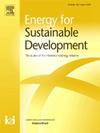测量家庭规模圆顶沼气池的过压沼气排放:肯尼亚和乌干达的案例研究
IF 4.9
2区 工程技术
Q2 ENERGY & FUELS
引用次数: 0
摘要
家庭规模的沼气池的甲烷排放是一个潜在的重大气候问题,但在农村能源获取计划中却基本上被忽视了。这项研究首次对肯尼亚和乌干达53个家庭规模的沼气池的沼气排放模式进行了评估,该模式由超压引起。我们开发并应用了一种使用被称为“智能沼气”的数字监测技术来估计排气的方法,该技术可以连续测量压力和流量数据,以量化沼气损失的体积和时间。我们的发现揭示了家庭沼气使用的复杂情况。通过测量沼气利用系数(BUF)——消耗的沼气与产生的沼气的比率,较低的BUF表明较高的排气率——我们发现,在最佳时期,家庭可以实现出色的性能,所有沼气池的排气率都低于3%,这表明了优化沼气利用的潜力。然而,尽管大多数家庭在大部分时间保持良好的沼气利用,但周期性的利用不足会显著影响整体表现。平均压力驱动排气率从10立方米蒸煮器的10.8%±12.7%到6立方米蒸煮器的20.9%±20.9%(总体平均值:15.9%±20.2%)。时间模式也会出现,在下午和夜间以及农业种植季节,当烹饪模式发生变化时,排气可能会增加。根据这些见解,我们提出了帮助家庭在最佳时期保持一致的高沼气利用率的策略。本文中开发的方法可以应用于其他沼气项目,以建立对沼气使用模式和排放可能性的更广泛理解。这些发现对沼气方案设计、碳信用方法以及使小型沼气系统的气候效益和家庭价值最大化的努力具有启示意义。本文章由计算机程序翻译,如有差异,请以英文原文为准。
Measuring biogas venting from over-pressurisation of household scale dome biogas digesters: A case study in Kenya and Uganda
Methane emissions from household-scale biogas digesters represent a potentially significant climate concern that has been largely overlooked in rural energy access programmes. This study presents the first assessment of biogas venting patterns, resulting from over-pressure, across 53 household-scale biogas digesters in Kenya and Uganda. We develop and apply a methodology for estimating venting using digital monitoring technology known as ‘Smart Biogas’, which continuously measures pressure and flow data to quantify both the volume and timing of biogas loss.
Our findings reveal a complex picture of household biogas use. By measuring the Biogas Utilisation Factor (BUF) - the ratio of consumed to generated biogas, where a lower BUF indicates higher venting rates - we found that households can achieve excellent performance during optimal periods, with venting rates below 3 % across all digester sizes, which demonstrates the potential for optimised biogas use. However, although most households maintain good biogas utilisation most of the time, periodic episodes of underuse significantly impact overall performance. The mean pressure-driven venting rates ranged from 10.8 % ± 12.7 % for 10 m3 digesters to 20.9 % ± 20.9 % for 6 m3 digesters (overall mean: 15.9 % ± 20.2 %). Temporal patterns also emerge, with increased venting likely during afternoon and nighttime hours, and during agricultural planting seasons when cooking patterns change. Drawing from these insights, we propose strategies to help households maintain the consistent high biogas utilisation they achieve during optimal periods.
The methodology developed in this paper can be applied across other biogas programmes to build a broader understanding of patterns of biogas use and the likelihood of venting. These findings have implications for biogas programme design, carbon credit methodologies, and efforts to maximise both the climate benefits and household value of small-scale biogas systems.
求助全文
通过发布文献求助,成功后即可免费获取论文全文。
去求助
来源期刊

Energy for Sustainable Development
ENERGY & FUELS-ENERGY & FUELS
CiteScore
8.10
自引率
9.10%
发文量
187
审稿时长
6-12 weeks
期刊介绍:
Published on behalf of the International Energy Initiative, Energy for Sustainable Development is the journal for decision makers, managers, consultants, policy makers, planners and researchers in both government and non-government organizations. It publishes original research and reviews about energy in developing countries, sustainable development, energy resources, technologies, policies and interactions.
 求助内容:
求助内容: 应助结果提醒方式:
应助结果提醒方式:


